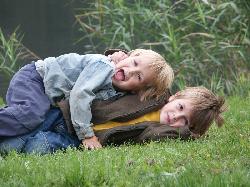Teaching Children with Learning Disabilities to Make Friends

Children with learning disabilities often have trouble making and retaining friendships. Some kids know the social graces of initiating friendships, but have no idea how to sustain the relationship. Kids with learning disabilities often allow friendships to end because they don’t understand how to work out the conflicts that occur on the schoolyard or in the community. Harmless jokes and teasing may appear as negative to children with learning disabilities because they have difficulty processing language or they have trouble listening and deciphering words and body language. These kids may not comprehend verbal and non-verbal communication or they may see all situations as black and white with no gray areas.
Many children who struggle with learning disabilities think that if they hear the words of a friend that they understand what he is communicating. Nothing could be farther from the truth. Non-verbal expressions, such as body language and voice tone are very relevant in understanding a friend’s intent. The learning disabled child may focus so much on the friend’s verbal message that he misses the subtle message that is communicated in non-verbally.
Children with learning disabilities struggle to decipher messages when their friend’s body and verbal language contradicts each other. This can be most confusing and the learning disabled child may not interpret the message correctly if they:
Children with learning disabilities often take the words of their classmates and friends too literally. While kids may have been taught academic skills and how to listen, they often have never learned how to interpret body language, especially when it disagrees with words being spoken.
It is important that kids with learning disabilities understand that when verbal and non-verbal communication conflicts, that their attention should focus on the non-verbal message.
Non-verbal messages are communicated by the following:
People often find it easy to say what is expected of them, but if their feelings conflict with what they are saying, body language will oppose their words.
Body language that contradicts verbal communication includes:
Though most children understand the concept of body language, those with learning disabilities do not.
Teaching non-verbal cues to children with disabilities is an important part of their social integration. These kids will often respond positively to body language if they are taught specific lessons and practice with family and friends. Teach your child to ask himself the following questions about people who are communicating with him verbally:
Teach your disabled child that when words and body language conflict, there are a wide variety of methods to interpret the communication. Possibly the person is trying to avoid answering a question or even a direct confrontation. These avoidances cause confusion in the minds of children with learning disabilities, because the real message is conveyed by use of body language. Kids that have learning disabilities prefer a direct message such as, “I don’t want to play with you right now,” or “I can’t play with you right now.” This lets the child with the learning disability know the exact message that is being conveyed. However, most kids avoid being so direct.
Kids with learning disabilities can be taught to resolve conflict. Kids can be cruel, but that is often not their intention. Children who have learning disabilities project negativity to other children in order to avoid being hurt. They may feel that their friend is being critical when no criticism was intended, or they take a situation that was meant as a joke seriously. This causes negative social consequences because the learning disabled child reacts with anger or they withdraw. The learning disabled child doesn’t take the time to consider their friend’s intentions and may end the relationship because they have very few resolution skills.
Children with learning disabilities can become better listeners of both verbal and non-verbal communication by:
Children with learning disabilities can be taught to make and retain friendships among their school peers by being taught body language and basic non-verbal message interpretation. This will enhance their social skills, which will make it much easier for them to make friends.
Friends and long-term friendships are an important part of life for everyone, but even more so for children with learning disabilities. They need the support of friends in the classroom, in the schoolyard and in the community.
Help your learning disabled child how to approach other children, how to interpret body language and how to understand non-verbal cues. This will allow him to make and sustain friendships so he will have more opportunities to see himself as being the same as everyone else. These skills will follow him into adulthood and he will use them for the rest of his life. This will allow him to make friends, have a support network and lead a full and happy life.
- Helping Your Learning Disabled ChildThousands of children in America struggle to learn on a daily basis. Many of them have invisible disabilities. In fact, five to eight percent of the population has learning disabilities that range...
- Asperger Syndrome: A Developmental Disorder on the Autism SpectrumAsperger Syndrome, also known as Pervasive Developmental Disorder is on the high functioning end of the autism spectrum. It was identified by Dr. Hans Asperger, a physician from Vienna in 1944. He...
- Special Needs Education: Your Child, Your RightsMany children today have special needs that make it difficult for them to learn. It’s imperative for you, as a parent to be aware of both your rights and your child’s within the education system....

